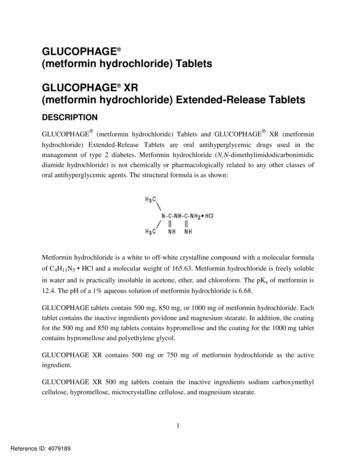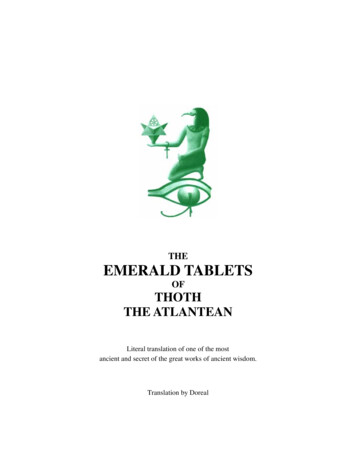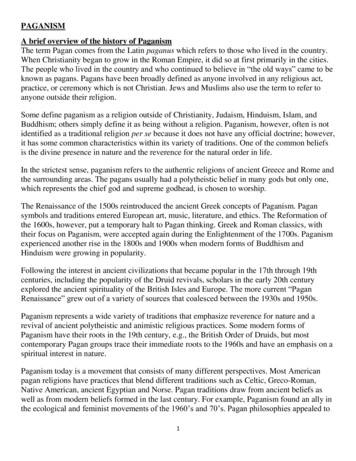
Transcription
GLUCOPHAGE (metformin hydrochloride) TabletsGLUCOPHAGE XR(metformin hydrochloride) Extended-Release TabletsDESCRIPTION GLUCOPHAGE (metformin hydrochloride) Tablets and GLUCOPHAGEXR (metforminhydrochloride) Extended-Release Tablets are oral antihyperglycemic drugs used in themanagement of type 2 diabetes. Metformin hydrochloride (N,N-dimethylimidodicarbonimidicdiamide hydrochloride) is not chemically or pharmacologically related to any other classes oforal antihyperglycemic agents. The structural formula is as shown:Metformin hydrochloride is a white to off-white crystalline compound with a molecular formulaof C4H11N5 HCl and a molecular weight of 165.63. Metformin hydrochloride is freely solublein water and is practically insoluble in acetone, ether, and chloroform. The pKa of metformin is12.4. The pH of a 1% aqueous solution of metformin hydrochloride is 6.68.GLUCOPHAGE tablets contain 500 mg, 850 mg, or 1000 mg of metformin hydrochloride. Eachtablet contains the inactive ingredients povidone and magnesium stearate. In addition, the coatingfor the 500 mg and 850 mg tablets contains hypromellose and the coating for the 1000 mg tabletcontains hypromellose and polyethylene glycol.GLUCOPHAGE XR contains 500 mg or 750 mg of metformin hydrochloride as the activeingredient.GLUCOPHAGE XR 500 mg tablets contain the inactive ingredients sodium carboxymethylcellulose, hypromellose, microcrystalline cellulose, and magnesium stearate.1Reference ID: 4079189
GLUCOPHAGE XR 750 mg tablets contain the inactive ingredients sodium carboxymethylcellulose, hypromellose, and magnesium stearate.System Components and Performance–GLUCOPHAGE XR comprises a dual hydrophilicpolymer matrix system. Metformin hydrochloride is combined with a drug release controllingpolymer to form an "inner" phase, which is then incorporated as discrete particles into an"external" phase of a second polymer. After administration, fluid from the gastrointestinal (GI)tract enters the tablet, causing the polymers to hydrate and swell. Drug is released slowly fromthe dosage form by a process of diffusion through the gel matrix that is essentially independentof pH. The hydrated polymer system is not rigid and is expected to be broken up by normalperistalsis in the GI tract. The biologically inert components of the tablet may occasionallyremain intact during GI transit and will be eliminated in the feces as a soft, hydrated mass.CLINICAL PHARMACOLOGYMechanism of ActionMetformin is an antihyperglycemic agent which improves glucose tolerance in patients with type2 diabetes, lowering both basal and postprandial plasma glucose. Its pharmacologic mechanismsof action are different from other classes of oral antihyperglycemic agents. Metformin decreaseshepatic glucose production, decreases intestinal absorption of glucose, and improves insulinsensitivity by increasing peripheral glucose uptake and utilization. Unlike sulfonylureas,metformin does not produce hypoglycemia in either patients with type 2 diabetes or normalsubjects (except in special circumstances, see PRECAUTIONS) and does not causehyperinsulinemia. With metformin therapy, insulin secretion remains unchanged while fastinginsulin levels and day-long plasma insulin response may actually decrease.PharmacokineticsAbsorption and BioavailabilityThe absolute bioavailability of a GLUCOPHAGE 500 mg tablet given under fasting conditionsis approximately 50% to 60%. Studies using single oral doses of GLUCOPHAGE 500 to1500 mg, and 850 to 2550 mg, indicate that there is a lack of dose proportionality withincreasing doses, which is due to decreased absorption rather than an alteration in elimination.Food decreases the extent of and slightly delays the absorption of metformin, as shown byapproximately a 40% lower mean peak plasma concentration (Cmax), a 25% lower area under theplasma concentration versus time curve (AUC), and a 35-minute prolongation of time to peakplasma concentration (Tmax) following administration of a single 850 mg tablet of metformin2Reference ID: 4079189
with food, compared to the same tablet strength administered fasting. The clinical relevance ofthese decreases is unknown.Following a single oral dose of GLUCOPHAGE XR, Cmax is achieved with a median value of7 hours and a range of 4 to 8 hours. Peak plasma levels are approximately 20% lower comparedto the same dose of GLUCOPHAGE, however, the extent of absorption (as measured by AUC)is similar to GLUCOPHAGE.At steady state, the AUC and Cmax are less than dose proportional for GLUCOPHAGE XRwithin the range of 500 to 2000 mg administered once daily. Peak plasma levels areapproximately 0.6, 1.1, 1.4, and 1.8 µg/mL for 500, 1000, 1500, and 2000 mg once-daily doses,respectively. The extent of metformin absorption (as measured by AUC) fromGLUCOPHAGE XR at a 2000 mg once-daily dose is similar to the same total daily doseadministered as GLUCOPHAGE tablets 1000 mg twice daily. After repeated administration ofGLUCOPHAGE XR, metformin did not accumulate in plasma.Within-subject variability in Cmax and AUC of metformin from GLUCOPHAGE XR iscomparable to that with GLUCOPHAGE.Although the extent of metformin absorption (as measured by AUC) from theGLUCOPHAGE XR tablet increased by approximately 50% when given with food, there was noeffect of food on Cmax and Tmax of metformin. Both high and low fat meals had the same effecton the pharmacokinetics of GLUCOPHAGE XR.DistributionThe apparent volume of distribution (V/F) of metformin following single oral doses ofGLUCOPHAGE 850 mg averaged 654 358 L. Metformin is negligibly bound to plasmaproteins, in contrast to sulfonylureas, which are more than 90% protein bound. Metforminpartitions into erythrocytes, most likely as a function of time. At usual clinical doses and dosingschedules of GLUCOPHAGE, steady state plasma concentrations of metformin are reachedwithin 24 to 48 hours and are generally 1 µg/mL. During controlled clinical trials ofGLUCOPHAGE, maximum metformin plasma levels did not exceed 5 µg/mL, even at maximumdoses.Metabolism and EliminationIntravenous single-dose studies in normal subjects demonstrate that metformin is excretedunchanged in the urine and does not undergo hepatic metabolism (no metabolites have been3Reference ID: 4079189
identified in humans) nor biliary excretion. Renal clearance (see Table 1) is approximately3.5 times greater than creatinine clearance, which indicates that tubular secretion is the majorroute of metformin elimination. Following oral administration, approximately 90% of theabsorbed drug is eliminated via the renal route within the first 24 hours, with a plasmaelimination half-life of approximately 6.2 hours. In blood, the elimination half-life isapproximately 17.6 hours, suggesting that the erythrocyte mass may be a compartment ofdistribution.Specific PopulationsPatients with Type 2 DiabetesIn the presence of normal renal function, there are no differences between single- or multipledose pharmacokinetics of metformin between patients with type 2 diabetes and normal subjects(see Table 1), nor is there any accumulation of metformin in either group at usual clinical doses.The pharmacokinetics of GLUCOPHAGE XR in patients with type 2 diabetes are comparable tothose in healthy normal adults.Renal ImpairmentIn patients with decreased renal function, the plasma and blood half-life of metformin isprolonged and the renal clearance is decreased (see Table 1; also seeCONTRAINDICATIONS, WARNINGS, PRECAUTIONS, and DOSAGE ANDADMINISTRATION).Hepatic ImpairmentNo pharmacokinetic studies of metformin have been conducted in patients with hepaticinsufficiency (see PRECAUTIONS).GeriatricsLimited data from controlled pharmacokinetic studies of GLUCOPHAGE in healthy elderlysubjects suggest that total plasma clearance of metformin is decreased, the half-life is prolonged,and Cmax is increased, compared to healthy young subjects. From these data, it appears that thechange in metformin pharmacokinetics with aging is primarily accounted for by a change inrenal function (see Table 1; also see WARNINGS, PRECAUTIONS, and DOSAGE ANDADMINISTRATION).4Reference ID: 4079189
Table 1: Select Mean ( S.D.) Metformin Pharmacokinetic Parameters Following Single orMultiple Oral Doses of GLUCOPHAGEabcCmax(µg/mL)Tmax(hrs)Renal Clearance(mL/min)1.03 ( 0.33)2.75 ( 0.81)600 ( 132)1.60 ( 0.38)2.64 ( 0.82)552 ( 139)2.01 ( 0.42)1.79 ( 0.94)642 ( 173)1.48 ( 0.5)3.32 ( 1.08)491 ( 138)1.90 ( 0.62)2.01 ( 1.22)550 ( 160)2.45 ( 0.70)2.71 ( 1.05)412 ( 98)Mild (CLcr 61-90 mL/min) (5)1.86 ( 0.52)3.20 ( 0.45)384 ( 122)Moderate (CLcr 31-60 mL/min) (4)4.12 ( 1.83)3.75 ( 0.50)108 ( 57)Severe (CLcr 10-30 mL/min) (6)3.93 ( 0.92)4.01 ( 1.10)130 ( 90)Subject Groups: GLUCOPHAGE dose(number of subjects)Healthy, nondiabetic adults:500 mg single dose (24)850 mg single dose (74)de850 mg three times daily for 19 doses (9)Adults with type 2 diabetes:850 mg single dose (23)e850 mg three times daily for 19 doses (9)fElderly , healthy nondiabetic adults:850 mg single dose (12)Renal-impaired adults:850 mg single dosegabcdefgAll doses given fasting except the first 18 doses of the multiple dose studiesPeak plasma concentrationTime to peak plasma concentrationCombined results (average means) of five studies: mean age 32 years (range 23-59 years)Kinetic study done following dose 19, given fastingElderly subjects, mean age 71 years (range 65-81 years)2CLcr creatinine clearance normalized to body surface area of 1.73 mPediatricsAfter administration of a single oral GLUCOPHAGE 500 mg tablet with food, geometric meanmetformin Cmax and AUC differed less than 5% between pediatric type 2 diabetic patients(12-16 years of age) and gender- and weight-matched healthy adults (20-45 years of age), allwith normal renal function.GenderMetformin pharmacokinetic parameters did not differ significantly between normal subjects andpatients with type 2 diabetes when analyzed according to gender (males 19, females 16).5Reference ID: 4079189
Similarly, in controlled clinical studies in patients with type 2 diabetes, the antihyperglycemiceffect of GLUCOPHAGE was comparable in males and females.RaceNo studies of metformin pharmacokinetic parameters according to race have been performed. Incontrolled clinical studies of GLUCOPHAGE in patients with type 2 diabetes, theantihyperglycemic effect was comparable in whites (n 249), blacks (n 51), and Hispanics(n 24).Clinical StudiesGLUCOPHAGEIn a double-blind, placebo-controlled, multicenter US clinical trial involving obese patients withtype 2 diabetes whose hyperglycemia was not adequately controlled with dietary managementalone (baseline fasting plasma glucose [FPG] of approximately 240 mg/dL), treatment withGLUCOPHAGE (up to 2550 mg/day) for 29 weeks resulted in significant mean net reductions infasting and postprandial plasma glucose (PPG) and hemoglobin A1c (HbA1c) of 59 mg/dL,83 mg/dL, and 1.8%, respectively, compared to the placebo group (see Table 2).Table 2: GLUCOPHAGE vs Placebo Summary of Mean Changes from Baseline* inFasting Plasma Glucose, HbA1c, and Body Weight, at Final Visit (29-week study)FPG (mg/dL)BaselineChange at FINAL VISITHemoglobin A1c (%)BaselineChange at FINAL VISITBody Weight (lbs)BaselineChange at FINAL VISIT* All patients on diet therapy at BaselineGLUCOPHAGE(n 141)Placebo(n .20.4NS**0.001201.0–1.4206.0NS**–2.4NS**** Not statistically significantA 29-week, double-blind, placebo-controlled study of GLUCOPHAGE and glyburide, alone andin combination, was conducted in obese patients with type 2 diabetes who had failed to achieveadequate glycemic control while on maximum doses of glyburide (baseline FPG ofapproximately 250 mg/dL) (see Table 3). Patients randomized to the combination arm startedtherapy with GLUCOPHAGE 500 mg and glyburide 20 mg. At the end of each week of the first4 weeks of the trial, these patients had their dosages of GLUCOPHAGE increased by 500 mg ifthey had failed to reach target fasting plasma glucose. After week 4, such dosage adjustments6Reference ID: 4079189
were made monthly, although no patient was allowed to exceed GLUCOPHAGE 2500 mg.Patients in the GLUCOPHAGE only arm (metformin plus placebo) followed the same titrationschedule. At the end of the trial, approximately 70% of the patients in the combination groupwere taking GLUCOPHAGE 2000 mg/glyburide 20 mg or GLUCOPHAGE 2500 mg/glyburide20 mg. Patients randomized to continue on glyburide experienced worsening of glycemiccontrol, with mean increases in FPG, PPG, and HbA1c of 14 mg/dL, 3 mg/dL, and 0.2%,respectively. In contrast, those randomized to GLUCOPHAGE (up to 2500 mg/day) experienceda slight improvement, with mean reductions in FPG, PPG, and HbA1c of 1 mg/dL, 6 mg/dL, and0.4%, respectively. The combination of GLUCOPHAGE and glyburide was effective in reducingFPG, PPG, and HbA1c levels by 63 mg/dL, 65 mg/dL, and 1.7%, respectively. Compared toresults of glyburide treatment alone, the net differences with combination treatment were–77 mg/dL, –68 mg/dL, and –1.9%, respectively (see Table 3).Table 3: Combined GLUCOPHAGE/Glyburide (Comb) vs Glyburide (Glyb) orGLUCOPHAGE (GLU) Monotherapy: Summary of Mean Changes from Baseline* inFasting Plasma Glucose, HbA1c, and Body Weight, at Final Visit (29-week study)p-valuesFasting Plasma Glucose (mg/dL)BaselineChange at FINAL VISITComb(n 213)Glyb(n 209)GLU(n 210)Glyb vsCombGLU vsCombGLU **0.0010.0070.001203.0–0.7204.0–8.4Hemoglobin A1c (%)BaselineChange at FINAL VISITBody Weight (lbs)Baseline202.2Change at FINAL VISIT0.9* All patients on glyburide, 20 mg/day, at BaselineNS**NS**NS**0.0110.0010.001** Not statistically significantThe magnitude of the decline in fasting blood glucose concentration following the institution ofGLUCOPHAGE Tablets therapy was proportional to the level of fasting hyperglycemia. Patientswith type 2 diabetes with h
Drug is released slowly from the dosage form by a process of diffusion through the gel matrix that is essentially independent of pH. The hydrated polymer system is not rigid and is expected to be broken up by normal peristalsis in the GI tract. The biologically inert components of the tablet may occasionally remain intact during GI transit and will be eliminated in the feces as a soft .











